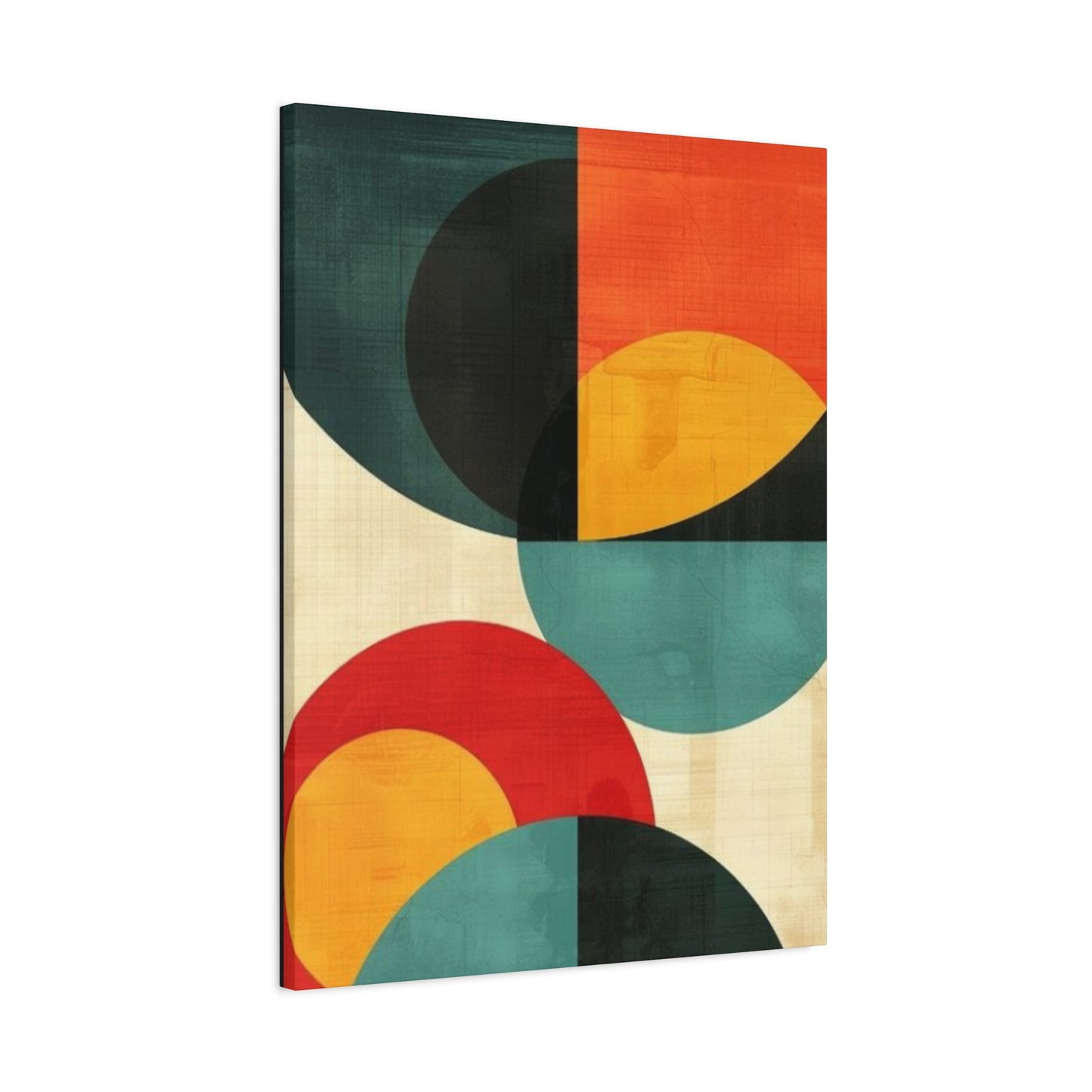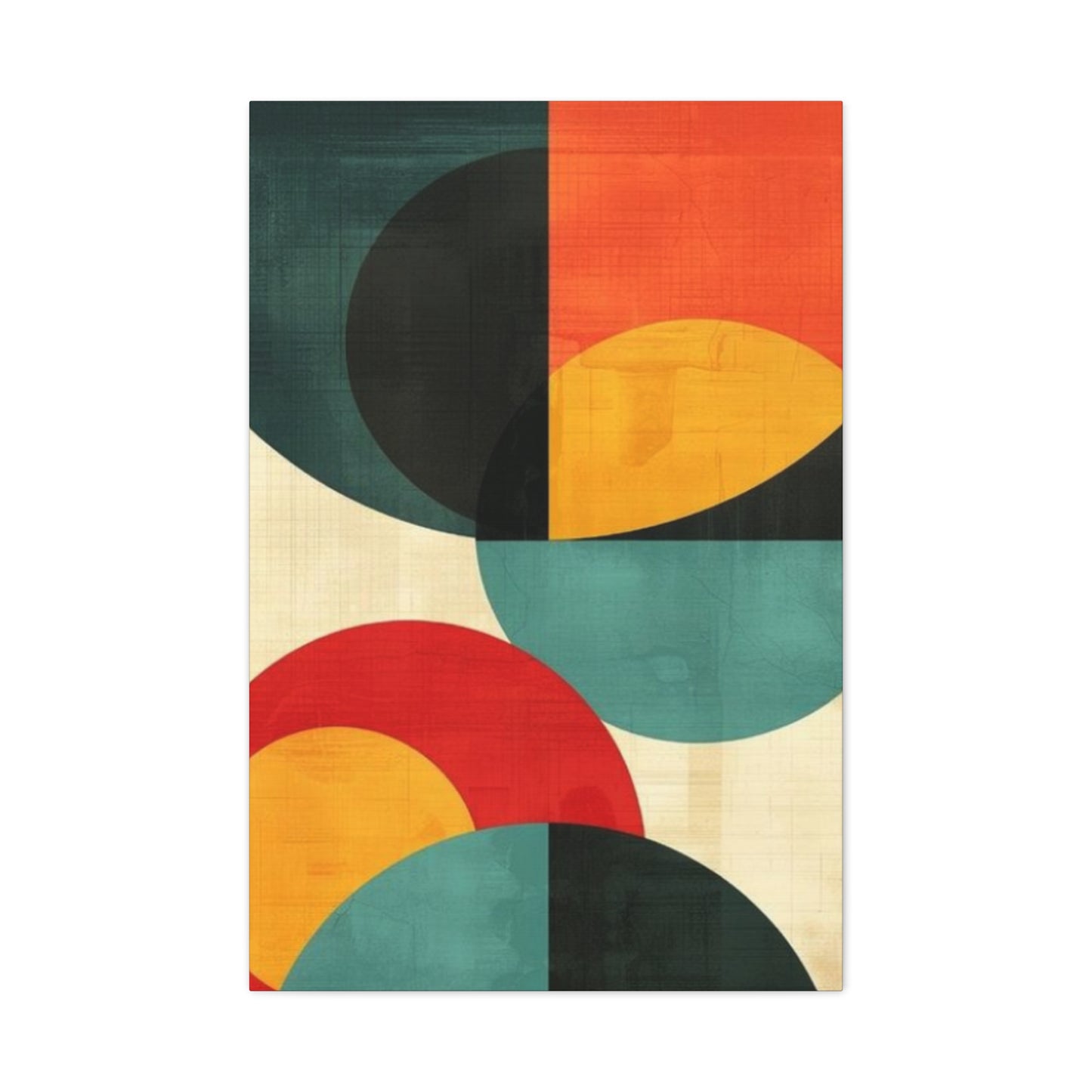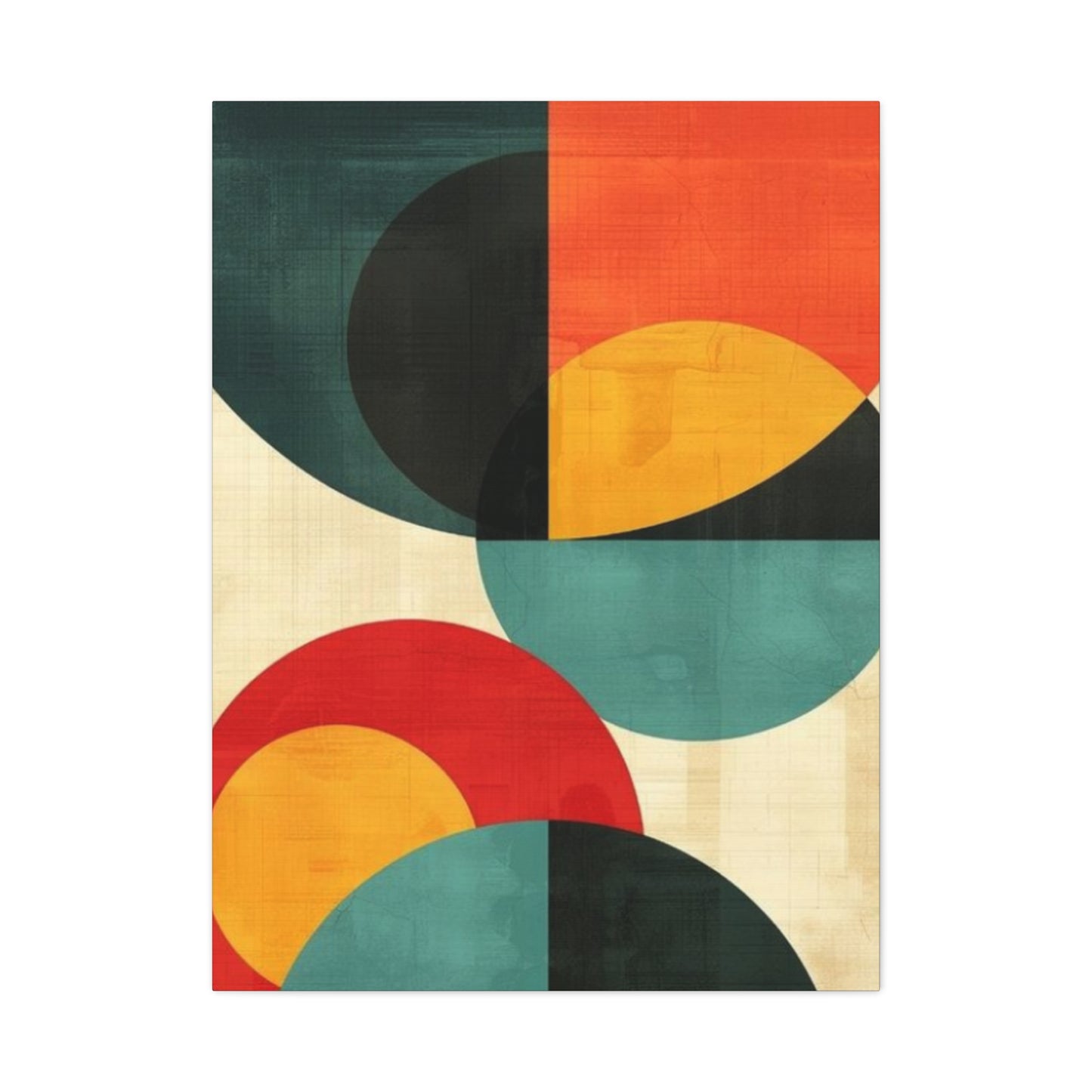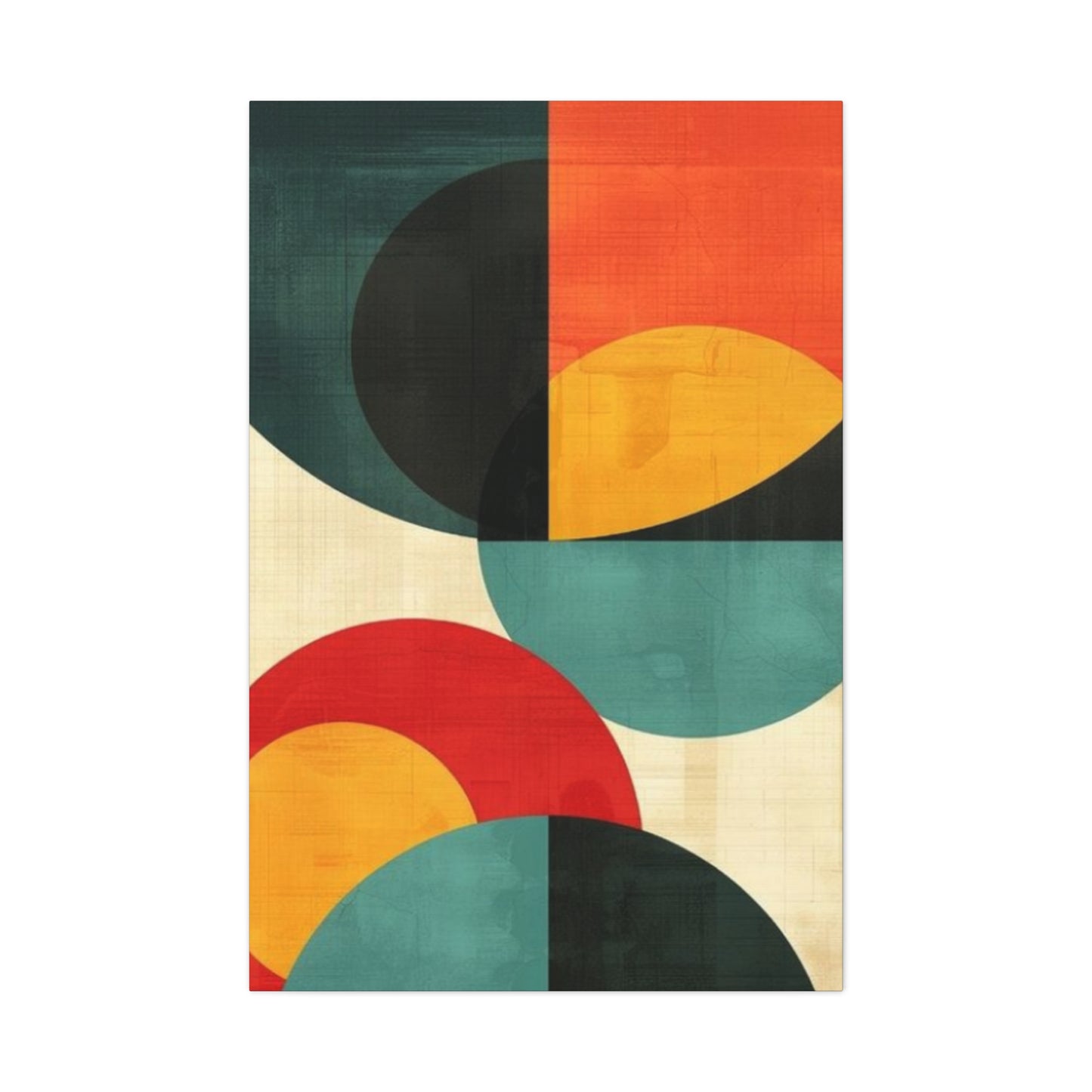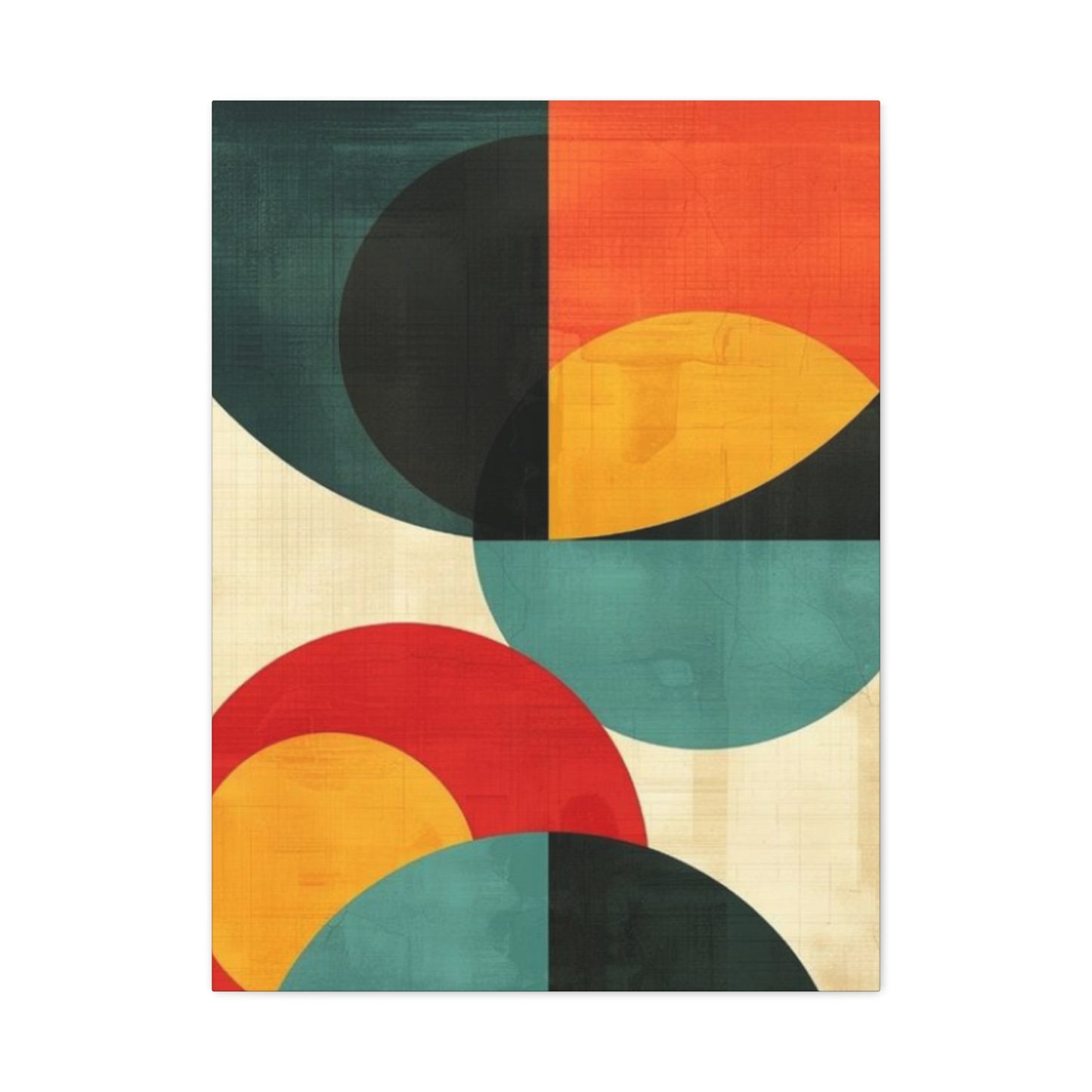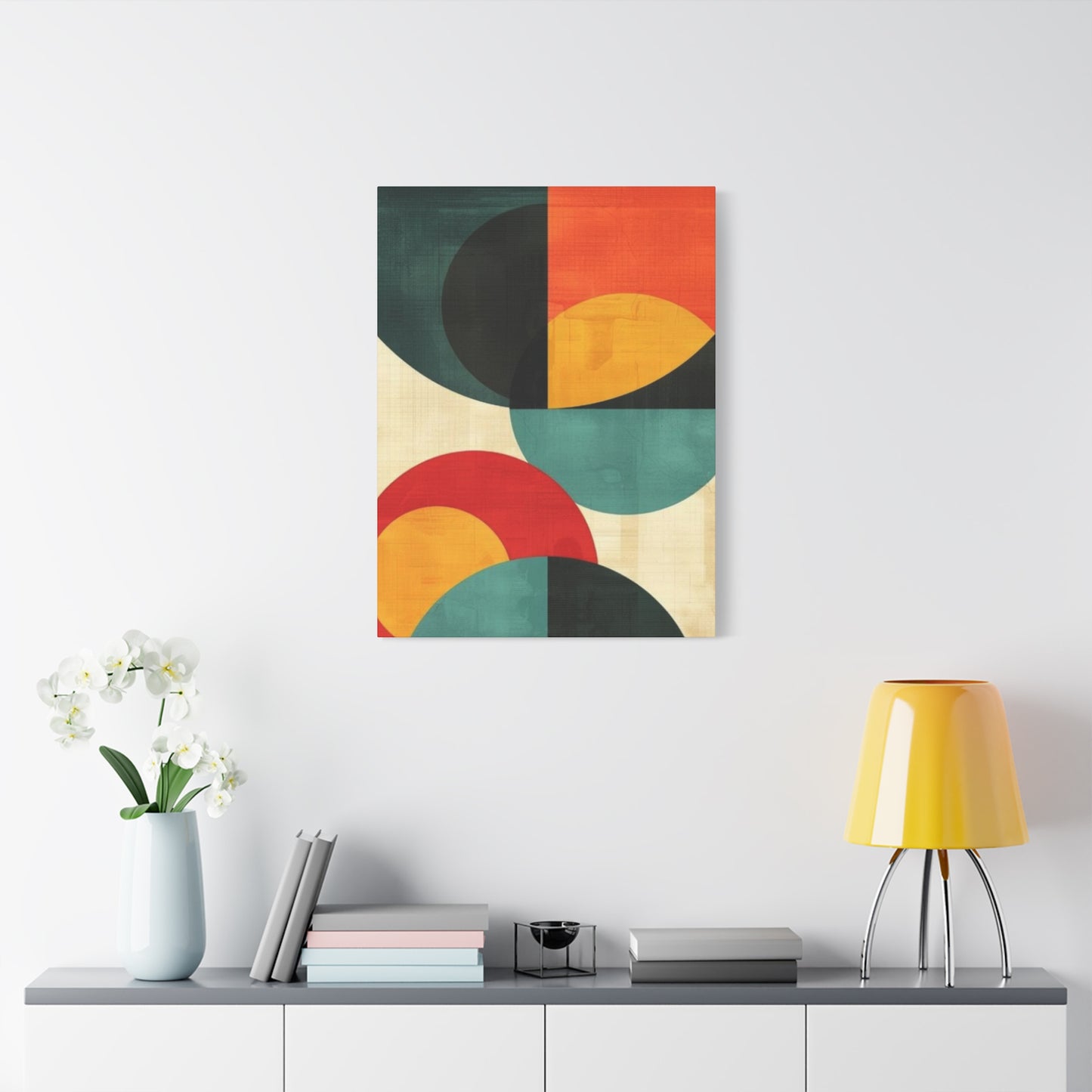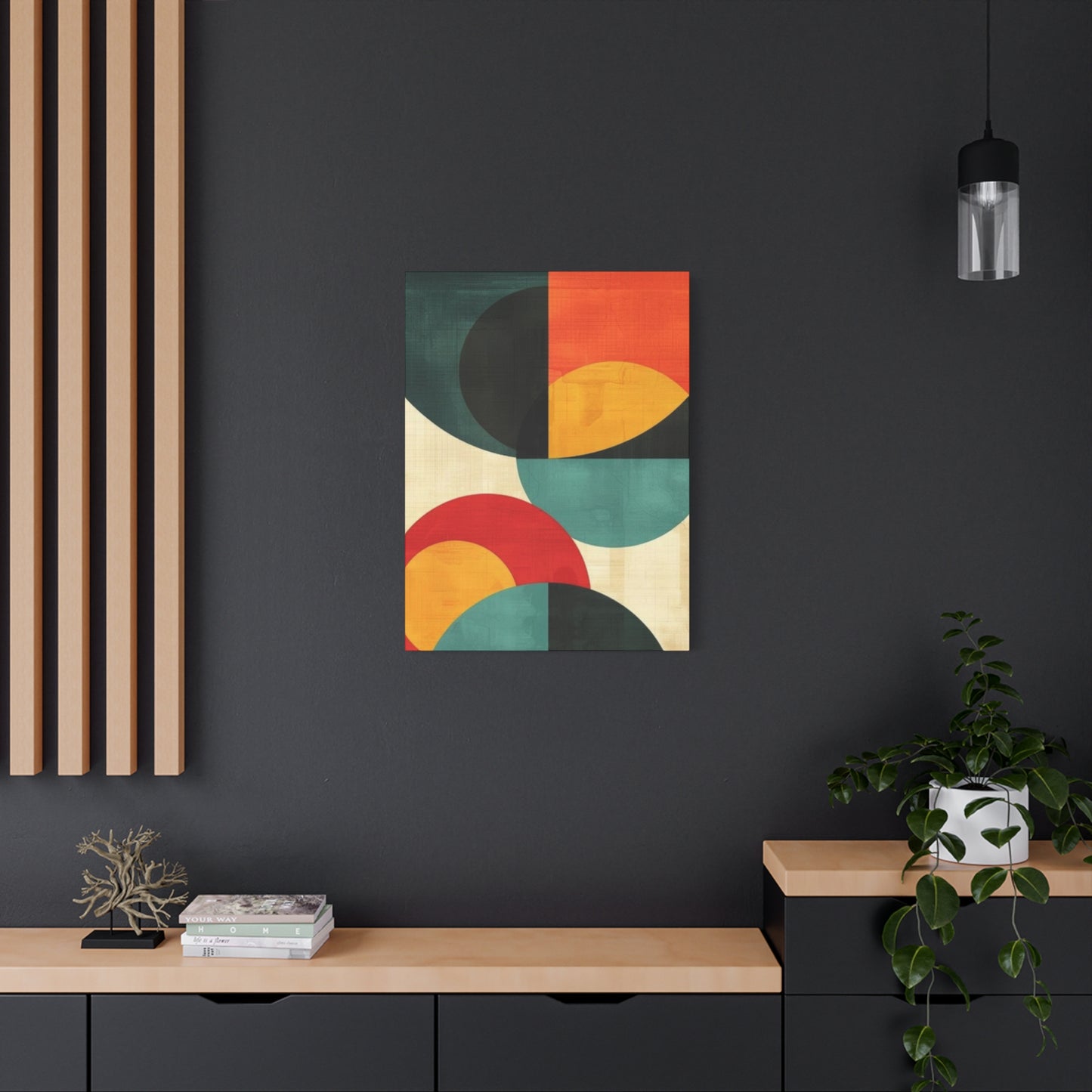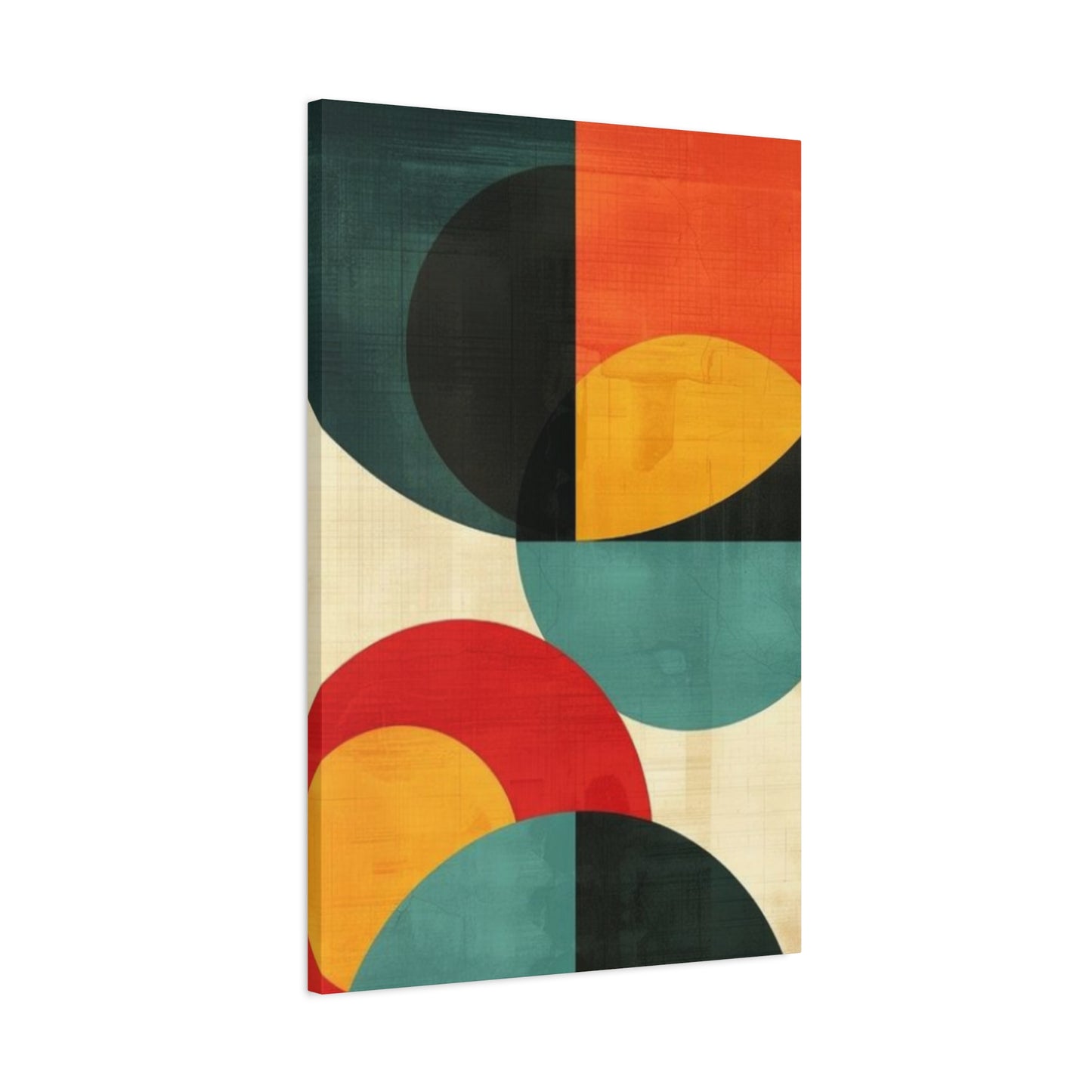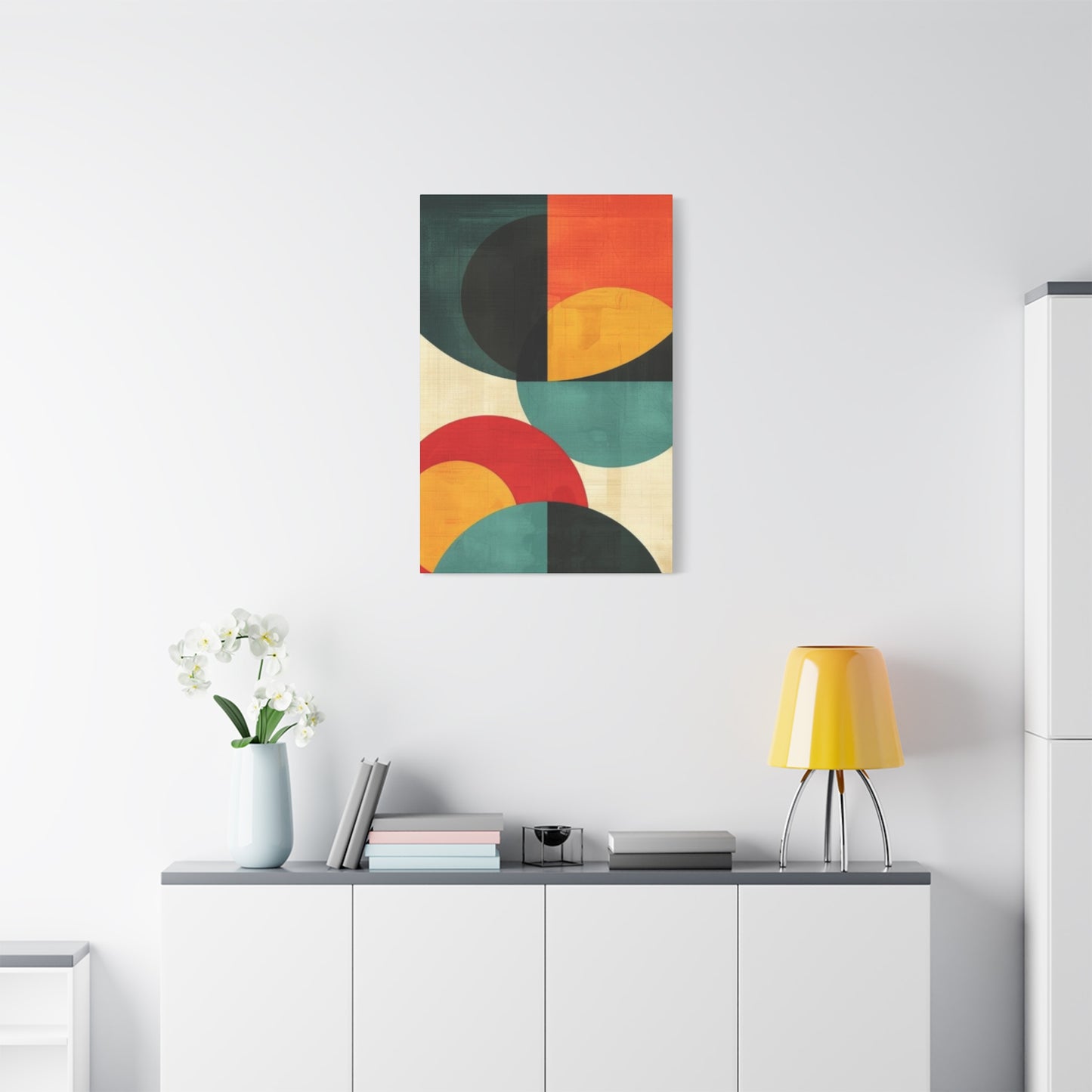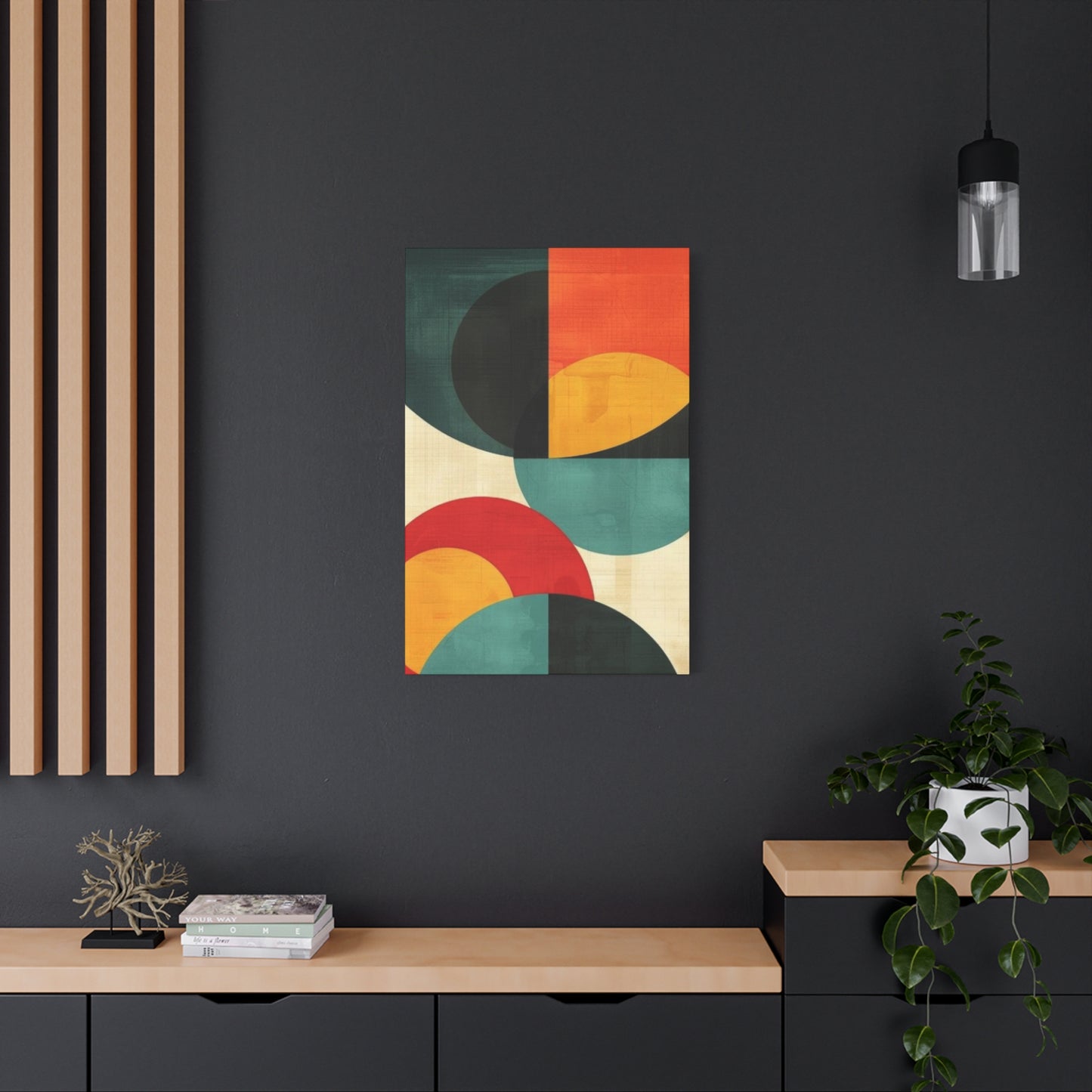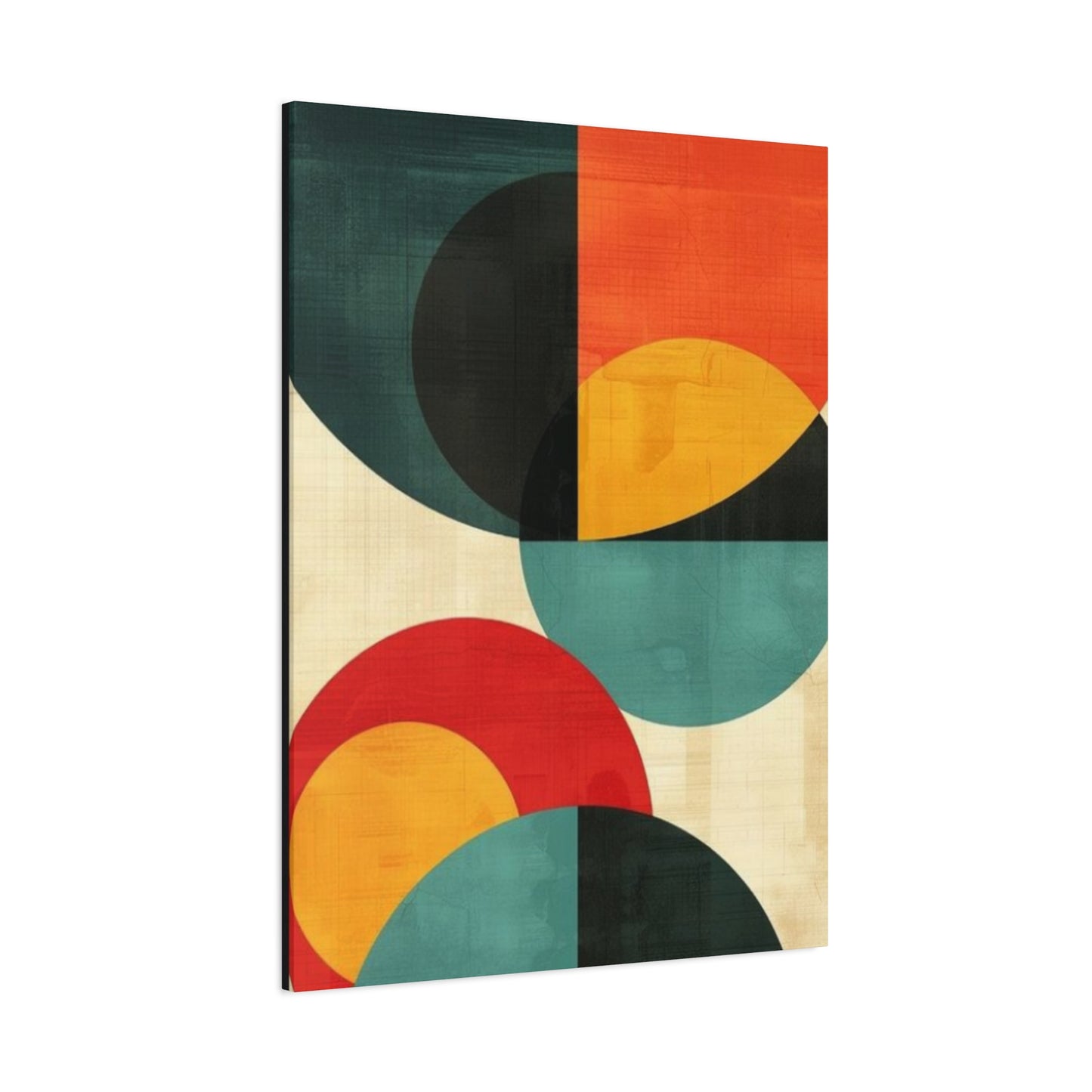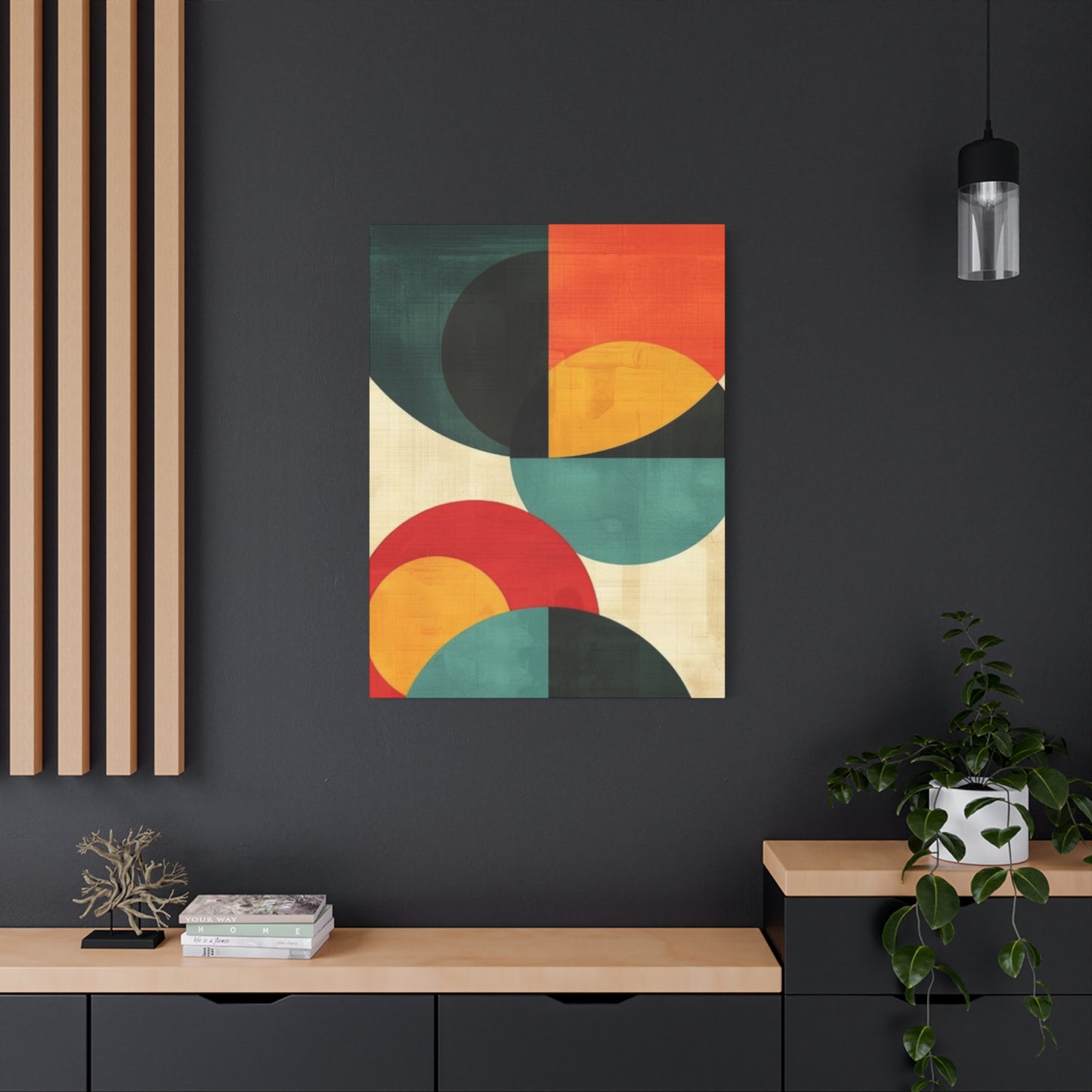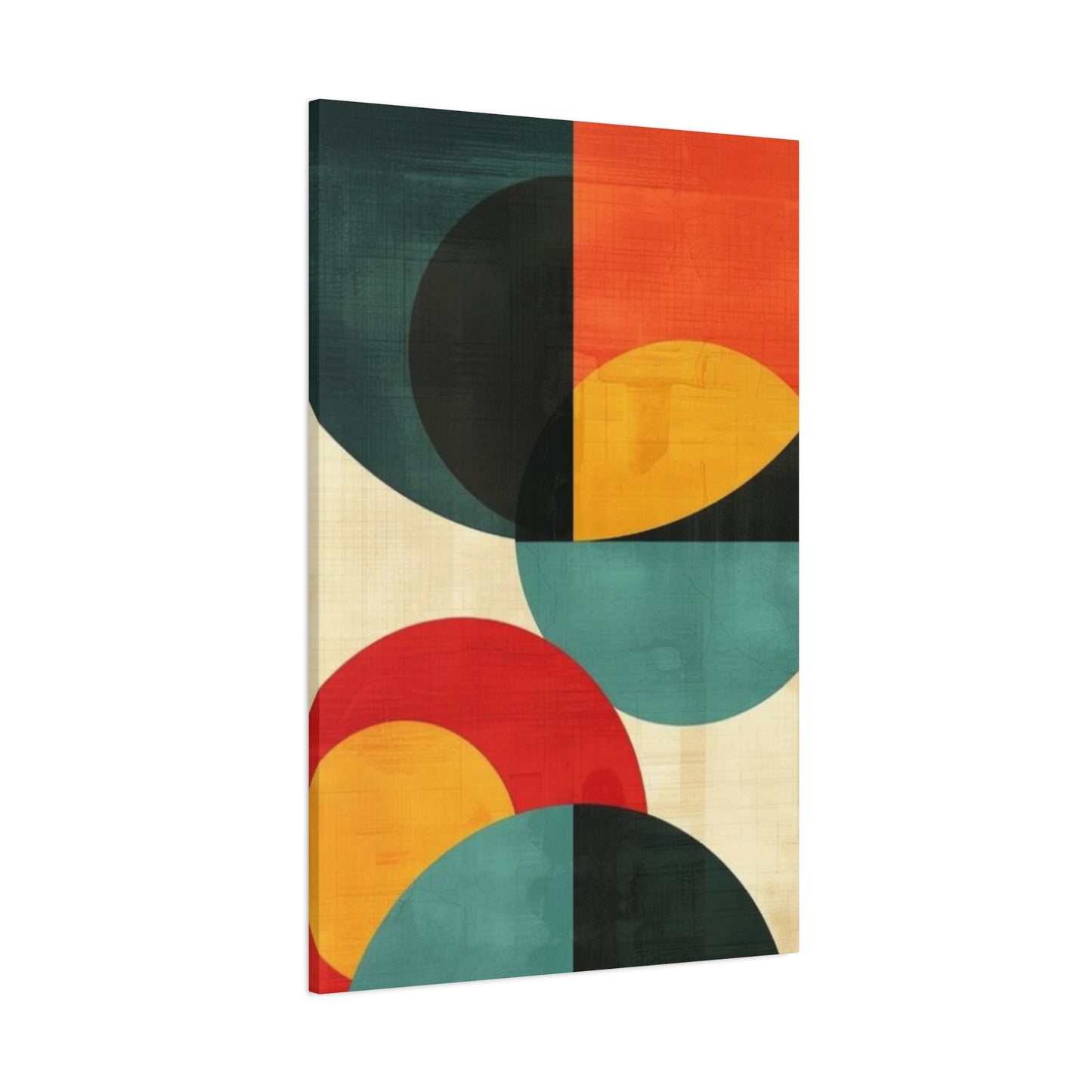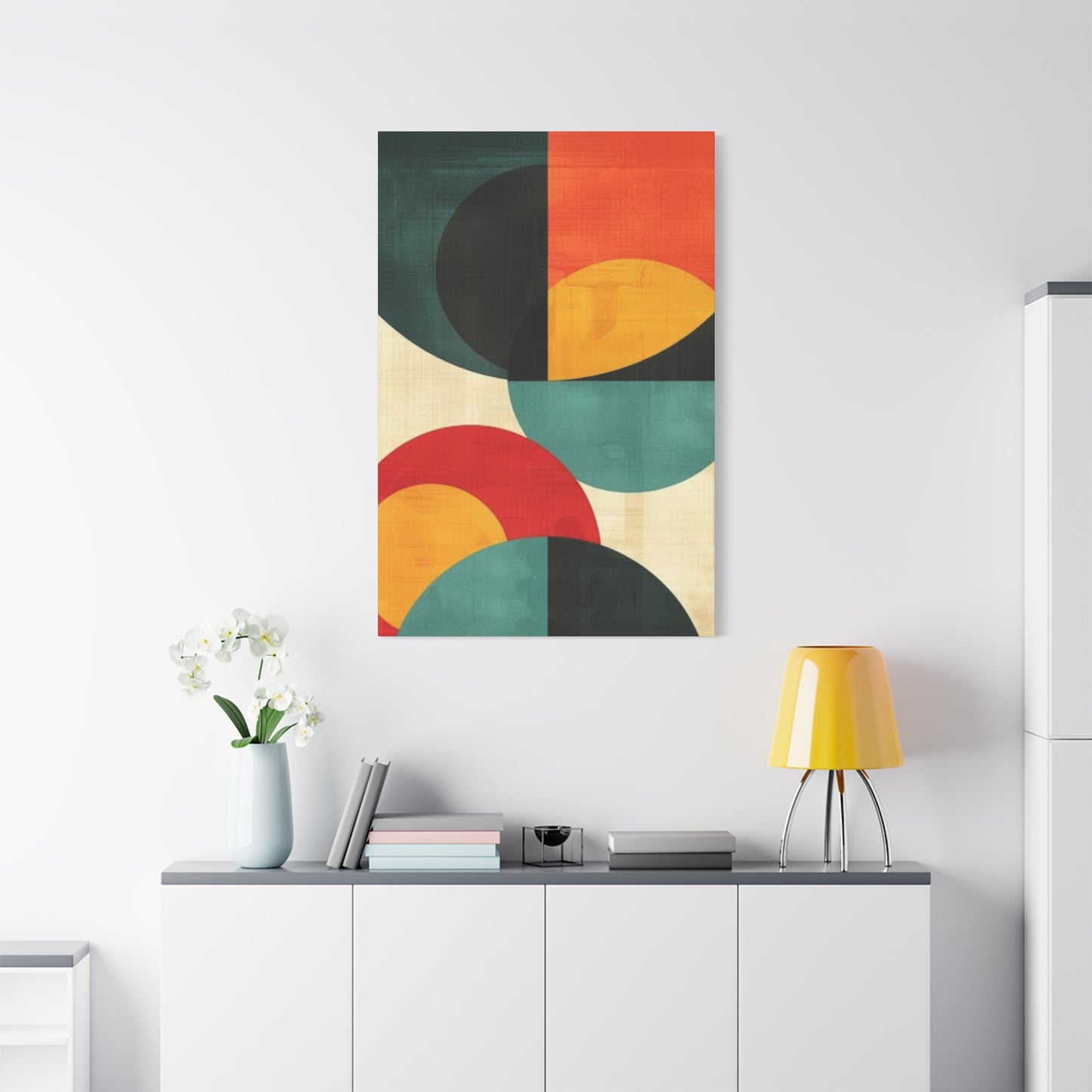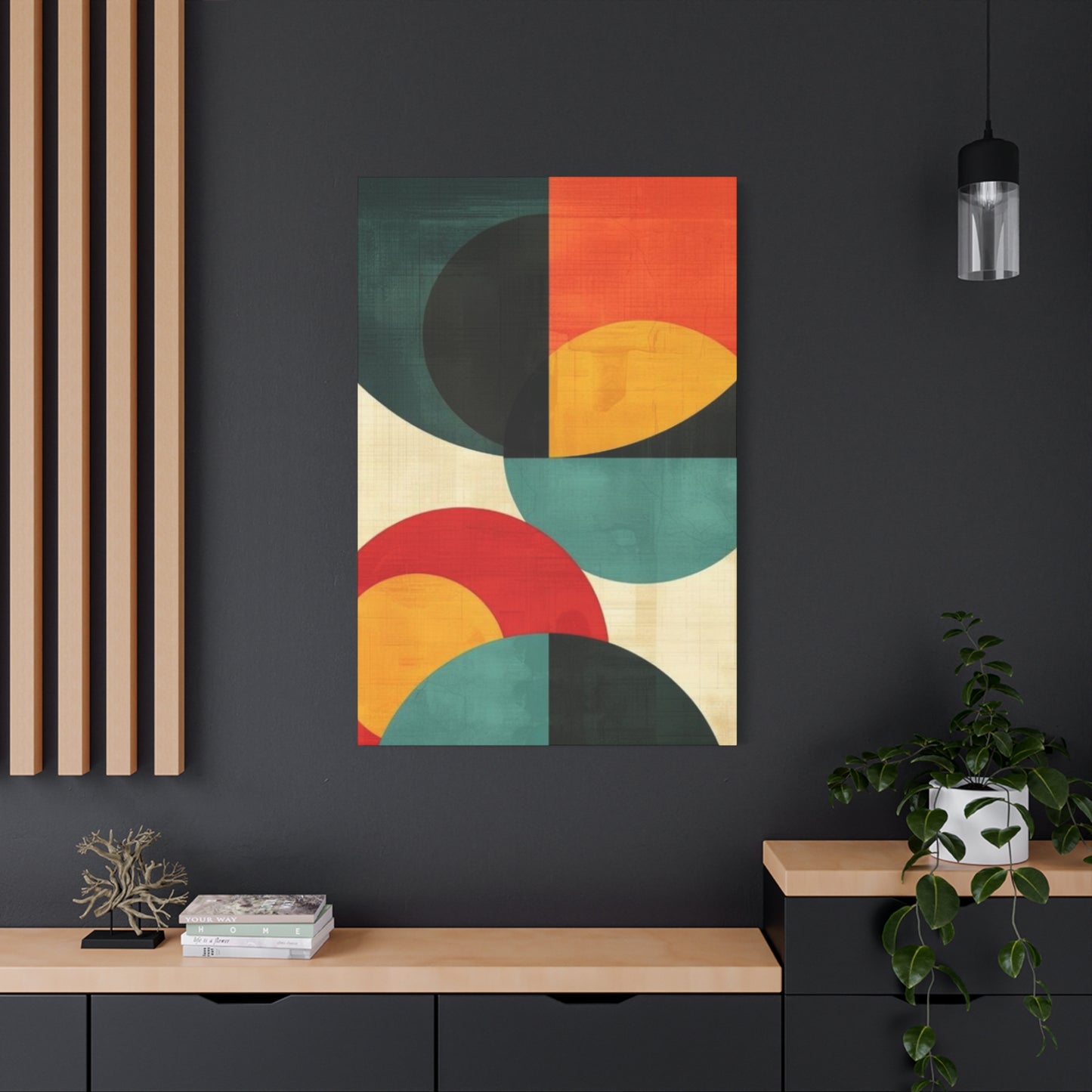Circular Abstract Modernism Wall Art: Bringing Vibrant Energy to Contemporary Living
Circular abstract modernism wall art represents a revolutionary approach to contemporary home decoration that combines the fundamental principles of geometric design with the expressive freedom of abstract artistry. This distinctive art form draws its inspiration from the modernist movement of the early 20th century, where artists began to break away from traditional representational forms to explore pure color, form, and emotion. The circular motif serves as both a structural foundation and a symbolic element, representing unity, continuity, and the cyclical nature of life itself.
The appeal of colorful circular abstract modernism lies in its ability to create visual harmony while maintaining dynamic energy within any living environment. These artworks typically feature bold, vibrant colors arranged in circular patterns that can range from simple concentric circles to complex overlapping forms that create depth and movement. The modernist influence ensures that these pieces maintain clean lines and purposeful composition, avoiding unnecessary embellishment while maximizing visual impact.
Contemporary homeowners are increasingly drawn to this art form because it offers versatility without sacrificing sophistication. The circular elements provide a sense of balance and completeness that can anchor a room's design scheme, while the abstract nature allows for personal interpretation and emotional connection. The modernist framework ensures that these pieces remain timeless rather than following fleeting trends, making them valuable long-term investments in home aesthetics.
The psychological impact of circular forms in art cannot be understated. Circles naturally draw the eye and create a sense of focus within a room, making them ideal for creating focal points or directing attention to specific areas. The abstract nature of these works allows viewers to engage with the art on multiple levels, finding new details and meanings with each viewing. This ongoing discovery process makes circular abstract modernism wall art particularly suitable for living areas where people spend significant time.
Historical Evolution of Modernist Wall Art Movements
The roots of circular abstract modernism can be traced back to the revolutionary artistic movements of the early 1900s, when artists began questioning traditional approaches to visual representation. Wassily Kandinsky, often credited as one of the pioneers of abstract art, was particularly fascinated by the spiritual and emotional properties of geometric forms, including circles. His theoretical writings on the spiritual nature of art laid the groundwork for understanding how simple geometric shapes could convey complex emotions and ideas.
The Bauhaus movement of the 1920s and 1930s played a crucial role in developing the modernist aesthetic that influences circular abstract wall art today. This German art school emphasized the unity of art and function, promoting clean lines, geometric forms, and bold color palettes. The Bauhaus philosophy that "form follows function" became a cornerstone of modernist design, influencing everything from architecture to graphic design to fine art.
During the mid-20th century, the Abstract Expressionist movement in America further developed these concepts, with artists like Kenneth Noland and Frank Stella creating works that featured bold geometric forms and vibrant colors. Their exploration of color relationships and spatial dynamics directly influenced the development of contemporary circular abstract art. These artists demonstrated how simple geometric forms could carry profound emotional and intellectual weight when properly executed.
The Pop Art movement of the 1960s introduced new approaches to color and form that continue to influence circular abstract modernism today. Artists began experimenting with brighter, more commercial color palettes and incorporating elements of popular culture into their geometric compositions. This period saw the emergence of art that was both accessible to general audiences and sophisticated in its execution, a balance that characterizes the best examples of contemporary circular abstract wall art.
The digital age has brought new tools and techniques to the creation of circular abstract modernism, allowing artists to explore color relationships and geometric forms with unprecedented precision. Computer-aided design has enabled the creation of complex circular patterns and color gradients that would have been impossible to achieve through traditional methods. This technological evolution has expanded the possibilities for circular abstract wall art while maintaining the fundamental principles of modernist design.
Color Psychology and Vibrant Palette Selection
The selection and application of color in circular abstract modernism wall art involves sophisticated understanding of color psychology and its impact on human emotion and behavior. Vibrant colors serve multiple functions within these compositions, from creating visual excitement to establishing mood and atmosphere within living environments. The circular format provides an ideal framework for exploring color relationships, as the curved forms naturally blend and flow into one another, creating smooth transitions and dynamic interactions.
Warm colors such as reds, oranges, and yellows tend to create feelings of energy, enthusiasm, and warmth when incorporated into circular abstract compositions. These colors naturally advance toward the viewer, making them excellent choices for creating focal points and drawing attention to specific areas of a room. When arranged in circular patterns, warm colors can create a sense of radiation and movement that energizes the entire visual field.
Cool colors including blues, greens, and purples offer contrasting effects, typically creating feelings of calm, stability, and introspection. In circular abstract modernism, cool colors often serve as grounding elements that balance the energy of warmer tones. The interplay between warm and cool colors within circular compositions creates visual tension and interest that keeps viewers engaged over time.
The psychological impact of color saturation plays a crucial role in the effectiveness of circular abstract wall art. Highly saturated colors create immediate visual impact and emotional response, while more muted tones allow for subtle sophistication and long-term viewing comfort. The best examples of circular abstract modernism often incorporate a range of saturation levels within a cohesive color scheme, creating depth and complexity that rewards close examination.
Color harmony principles such as complementary, analogous, and triadic relationships become particularly important in circular abstract compositions. The curved forms naturally guide the eye around the composition, making color transitions and relationships more apparent than they might be in angular or linear arrangements. Artists working in this style must carefully consider how colors interact not only adjacently but also across the entire circular format.
The cultural and personal associations that individuals bring to color interpretation add another layer of complexity to circular abstract modernism. While certain color responses appear to be universal, personal experiences and cultural backgrounds significantly influence how viewers interpret and respond to specific color combinations. This variability makes circular abstract wall art particularly personal and allows for individual connection and interpretation.
Geometric Principles in Circular Composition Design
The creation of effective circular abstract modernism wall art requires thorough understanding of geometric principles and their application to artistic composition. The circle itself serves as both a structural element and a symbolic form, providing a framework within which other geometric shapes and color relationships can be explored. The mathematical precision inherent in circular forms creates a sense of order and balance that appeals to both conscious and subconscious aesthetic preferences.
Concentric circles represent one of the most fundamental approaches to circular composition, creating natural depth and movement through the repetition of the basic form at different scales. This technique allows artists to explore color relationships systematically while maintaining overall visual coherence. The spacing between concentric circles can be varied to create rhythm and visual interest, with closer spacing creating more intense visual energy and wider spacing allowing for more contemplative viewing experiences.
The golden ratio and other mathematical proportions often influence the most successful circular abstract compositions. These naturally occurring ratios create visual harmony that appeals to human perception on a fundamental level. When applied to circular forms, these proportional relationships can determine the relative sizes of different elements, the positioning of focal points, and the overall balance of the composition.
Overlapping circular forms create complex geometric relationships that add depth and sophistication to abstract compositions. When circles of different sizes and colors overlap, they create new shapes and color mixtures that expand the visual possibilities of the artwork. These intersections become focal points that draw the eye and create visual pathways through the composition.
The relationship between positive and negative space becomes particularly important in circular abstract modernism. The areas between circular forms can be as visually important as the circles themselves, creating secondary patterns and relationships that add complexity to the overall design. Successful artists in this style learn to manipulate both positive and negative space to create balanced and engaging compositions.
Radial composition principles, where elements radiate outward from a central point, create natural movement and energy in circular abstract works. This approach can be used to create dramatic focal points or to distribute visual energy evenly throughout the composition. The radial approach works particularly well with vibrant color palettes, as it allows for smooth color transitions and gradient effects that enhance the overall visual impact.
Contemporary Home Integration Strategies
Successfully incorporating circular abstract modernism wall art into contemporary home environments requires careful consideration of architectural elements, existing decor, and lifestyle needs. The boldness and visual impact of these artworks make them natural focal points, but their integration must be balanced with other design elements to create cohesive and livable environments. The key lies in understanding how the artwork will interact with lighting, furniture, and spatial proportions.
Scale consideration represents one of the most critical factors in successful integration. Large-scale circular abstract pieces can serve as dramatic focal points in spacious rooms with high ceilings, while smaller works might be more appropriate for intimate settings or grouped together to create gallery walls. The relationship between the artwork size and room proportions significantly affects the visual impact and overall balance of the environment.
Lighting design plays a crucial role in presenting circular abstract modernism wall art effectively. Natural light can enhance the vibrancy of colors and reveal subtle details in the composition, while artificial lighting allows for controlled presentation and mood creation. Track lighting, picture lights, or strategically placed accent lights can highlight specific elements of the artwork while creating dramatic shadows and highlights that add depth to the viewing experience.
Furniture placement and selection must complement rather than compete with circular abstract wall art. Clean, modern furniture lines typically work best with these bold artistic statements, allowing the artwork to remain the primary visual focus while maintaining overall design cohesion. Neutral furniture colors can provide a sophisticated backdrop for vibrant artworks, while carefully selected accent pieces can echo colors or forms found in the art.
Color coordination between the artwork and existing decor elements requires subtle balance. While the circular abstract piece should maintain its visual prominence, incorporating some of its colors into accessories, textiles, or accent walls can create a sense of integration and intentional design. This approach prevents the artwork from appearing isolated while maintaining its impact as a focal point.
Room function considerations affect both artwork selection and placement decisions. Living areas and social spaces can accommodate more dynamic and energetic pieces, while bedrooms and private spaces might benefit from more subdued compositions. The viewing distances typical for different room types also influence scale and detail decisions in artwork selection.
Material Innovation and Production Techniques
The production of contemporary circular abstract modernism wall art has been revolutionized by advances in materials and printing technologies that allow for unprecedented color accuracy, durability, and scale possibilities. Traditional canvas remains a popular choice for its texture and artistic heritage, but modern alternatives offer advantages in specific applications and environments. Understanding these material options helps both artists and collectors make informed decisions about artwork selection and care.
High-quality digital printing on archival materials has democratized access to circular abstract modernism while maintaining artistic integrity. Advanced inkjet systems using pigment-based inks can reproduce color ranges that rival traditional painting techniques while offering superior fade resistance and longevity. These systems enable the creation of large-scale works that would be impractical or prohibitively expensive using traditional methods.
Canvas options have expanded beyond traditional cotton and linen to include synthetic materials that offer specific advantages. Polyester canvases resist stretching and maintain dimensional stability over time, making them ideal for large circular compositions where warping could distort the geometric precision. Some synthetic canvases also offer enhanced color saturation and faster drying times for artists working with acrylic paints.
Metal printing substrates, particularly aluminum, have gained popularity for circular abstract modernism due to their ability to produce extremely vibrant colors and sharp detail. The smooth surface of metal eliminates canvas texture, allowing pure color relationships to dominate the visual experience. Metal substrates also offer superior durability and resistance to environmental factors, making them suitable for challenging installation locations.
Glass and acrylic mounting systems provide protection while enhancing the presentation of circular abstract artworks. These transparent materials allow unobstructed viewing while protecting the artwork from environmental damage. Some acrylic systems incorporate anti-reflective coatings that eliminate glare issues that can interfere with the viewing experience, particularly important for artworks featuring highly saturated colors.
Three-dimensional presentation techniques add physical depth to circular abstract compositions, creating shadow effects and viewing angle variations that enhance the visual experience. Layered constructions, raised elements, and textured surfaces can transform flat abstract compositions into sculptural works that interact with their environment in dynamic ways. These techniques require careful consideration of lighting and viewing angles to achieve optimal effects.
Psychological Impact on Living Environments
The presence of vibrant circular abstract modernism wall art in living environments creates measurable psychological effects that extend beyond simple aesthetic appreciation. Research in environmental psychology demonstrates that visual art significantly influences mood, stress levels, and overall well-being of occupants. The specific characteristics of circular abstract modernism make these artworks particularly effective at creating positive psychological environments.
The circular form itself carries inherent psychological associations with completeness, unity, and harmony that can create calming effects even when rendered in vibrant colors. This paradoxical combination of energizing color with peaceful form creates a unique psychological balance that many people find appealing and restorative. The abstract nature of these works allows for personal interpretation and emotional projection, creating individualized psychological responses.
Color psychology research indicates that exposure to vibrant colors can increase energy levels, enhance creativity, and improve mood states. In circular abstract compositions, these effects are moderated by the geometric structure, preventing overstimulation while maintaining the positive benefits of color exposure. This balance makes vibrant circular abstract art suitable for environments where both stimulation and relaxation are desired.
The modernist aesthetic principles underlying these artworks contribute to feelings of order and control within living environments. The clean lines and purposeful composition create visual clarity that can reduce mental clutter and promote focused thinking. This psychological effect becomes particularly valuable in home offices or study areas where concentration is important.
Viewing complex abstract artworks engages cognitive processes that can provide mental stimulation and stress relief. The process of interpreting abstract forms and color relationships activates creative thinking pathways while providing a temporary escape from practical concerns. This cognitive engagement can be particularly beneficial for individuals whose work involves routine or repetitive tasks.
Long-term exposure to quality abstract art has been linked to increased aesthetic sensitivity and improved visual literacy. Living with circular abstract modernism wall art can enhance appreciation for design principles, color relationships, and compositional balance, potentially improving overall quality of life and environmental awareness. These educational benefits accumulate over time through daily exposure to well-designed artworks.
Cultural Significance and Global Perspectives
Circular abstract modernism wall art carries different cultural meanings and associations across global contexts, reflecting the diverse ways human societies interpret geometric forms and color relationships. While the modernist movement originated in Western Europe and America, its principles have been adopted and adapted by artists worldwide, creating rich cultural variations that enhance the universal appeal of circular abstract art.
Eastern philosophical traditions have long recognized the spiritual significance of circular forms, with the circle representing concepts such as enlightenment, completeness, and the eternal cycle of existence. When these cultural associations combine with modernist design principles, they create artworks that resonate across cultural boundaries while maintaining specific regional characteristics. Japanese concepts of negative space and Chinese principles of color harmony have particularly influenced contemporary circular abstract art.
Islamic geometric traditions provide another important cultural foundation for circular abstract modernism. The complex geometric patterns found in Islamic art demonstrate sophisticated understanding of mathematical relationships and their aesthetic applications. Contemporary artists working in circular abstract styles often draw inspiration from these traditions, creating works that bridge historical and modern approaches to geometric art.
African artistic traditions contribute bold color sensibilities and symbolic interpretations of circular forms that have influenced global approaches to abstract modernism. The use of earth tones combined with vibrant accents, geometric pattern repetition, and spiritual symbolism associated with circular forms all find expression in contemporary wall art that draws from African cultural heritage.
Latin American contributions to circular abstract modernism often emphasize emotional expression and cultural storytelling through abstract forms. The vibrant color palettes associated with Latin American art traditions translate particularly well to circular compositions, creating works that maintain cultural authenticity while embracing modernist design principles.
The globalization of art markets has created opportunities for cross-cultural fertilization in circular abstract modernism, with artists incorporating elements from multiple traditions into innovative contemporary works. This cultural blending has enriched the field while maintaining respect for traditional sources and meanings. The result is a more diverse and inclusive approach to circular abstract wall art that appeals to global audiences.
Investment Value and Market Trends
The market for circular abstract modernism wall art has experienced significant growth as contemporary collectors recognize both the aesthetic value and investment potential of high-quality pieces. This growth reflects broader trends in the art market toward accessible, contemporary works that combine artistic merit with decorative functionality. Understanding market dynamics helps both collectors and investors make informed decisions about acquiring circular abstract artworks.
Limited edition prints by established artists represent an accessible entry point into the circular abstract modernism market while offering potential appreciation value. The combination of artistic significance with production limitations creates scarcity that can drive value increases over time. Digital documentation and authentication systems have made it easier to verify edition sizes and authenticity, increasing confidence in the limited edition market.
Original artworks by emerging artists working in circular abstract styles offer potentially higher returns but require more careful evaluation of artistic merit and market potential. The development of an artist's reputation and exhibition history significantly affects the value trajectory of their works. Early acquisition of pieces by talented emerging artists can provide substantial returns as their careers develop.
Corporate collection trends increasingly favor contemporary abstract works that complement modern office environments while demonstrating cultural sophistication. Circular abstract modernism fits particularly well into corporate settings due to its professional appearance and positive psychological associations. This corporate demand provides a stable market foundation that supports overall value stability.
Online marketplace development has increased accessibility to circular abstract wall art while providing price transparency and market data that benefits both buyers and sellers. Digital platforms allow for detailed examination of artworks and direct communication between artists and collectors, reducing traditional gallery overhead while maintaining authentication and provenance documentation.
International market expansion has created global opportunities for artists working in circular abstract styles, with particular growth in Asian and Middle Eastern markets where geometric abstract art resonates with cultural traditions. This geographic diversification provides stability against regional economic fluctuations while opening new appreciation and acquisition opportunities.
Technical Considerations for Display and Preservation
Proper display and preservation of circular abstract modernism wall art requires attention to environmental factors that can affect both the artwork's appearance and longevity. The vibrant colors that characterize these works are particularly susceptible to fading from ultraviolet light exposure, making lighting selection and positioning crucial for long-term preservation. Understanding these technical requirements ensures that artworks maintain their visual impact and value over time.
Ultraviolet light filtration represents the most important preservation consideration for colorful abstract artworks. Museum-quality UV-filtering glass or acrylic glazing can block harmful wavelengths while maintaining color accuracy and visual clarity. Window films and LED lighting systems with minimal UV output further protect artworks from cumulative light damage that can significantly alter color relationships over time.
Humidity control affects both the artwork substrate and any protective glazing systems. Canvas-based works are particularly sensitive to humidity fluctuations that can cause expansion and contraction cycles leading to cracking or distortion. Maintaining stable humidity levels between 45-55% prevents most moisture-related deterioration while remaining comfortable for human occupation.
Temperature stability complements humidity control in creating optimal preservation environments. Rapid temperature changes can cause differential expansion of different materials within the artwork, potentially leading to separation or cracking. Avoiding installation locations near heating vents, fireplaces, or exterior walls helps maintain stable temperature conditions.
Mounting and hanging systems must accommodate the specific weight and dimensional characteristics of different artwork types. Large circular compositions may require specialized hardware to distribute weight evenly and prevent stress concentrations that could damage the artwork or wall surface. Professional installation ensures proper support while protecting both the artwork and the architectural surface.
Cleaning and maintenance procedures vary depending on the specific materials and production methods used in each artwork. Unglazed works typically require gentle dusting with soft brushes, while glazed pieces can accept mild cleaning solutions applied to the glazing surface only. Establishing appropriate maintenance schedules prevents accumulation of environmental contaminants that can affect appearance and preservation.
Creating Focal Points Through Strategic Placement
The strategic placement of circular abstract modernism wall art can transform ordinary rooms into dynamic environments that reflect sophisticated aesthetic sensibilities while serving practical lifestyle needs. The inherent visual strength of these artworks makes them natural focal points, but their effectiveness depends on careful consideration of sight lines, room proportions, and existing architectural features. Successful placement enhances both the artwork and the overall room design.
Entry area placement creates immediate visual impact and establishes aesthetic expectations for the entire home. A significant circular abstract piece in a foyer or hallway announces the homeowner's design sophistication while providing a welcoming focal point for guests. The viewing distance and lighting conditions in entry areas must be considered to ensure optimal presentation and impact.
Living room positioning typically centers on the primary seating area, with artworks placed to be easily viewed from multiple seating positions. The relationship between artwork height and furniture proportions affects both visual balance and viewing comfort. Artwork should typically be positioned so that its center falls at eye level for seated viewers, though this can be adjusted based on ceiling height and overall room scale.
Dining area installations benefit from artworks that enhance the social atmosphere while withstanding the environmental conditions associated with food service. Circular abstract pieces with warm, inviting color palettes can create intimate dining environments that encourage conversation and relaxation. The artwork should be positioned to avoid direct exposure to cooking vapors or serving activities that might cause accidental damage.
Bedroom placement requires consideration of the more personal and restful nature of these private environments. While circular abstract modernism can work well in bedrooms, color selection and saturation levels should support relaxation and sleep quality. Positioning artworks to be easily viewed from the bed while avoiding harsh lighting contrasts contributes to a peaceful environment.
Home office integration must balance visual stimulation with concentration requirements. Circular abstract artworks can provide creative inspiration and stress relief in work environments while maintaining professional appropriateness. Placement should avoid creating visual distractions during computer work while providing viewing opportunities during breaks or contemplative moments.
Color Harmony and Spatial Dynamics
The successful integration of circular abstract modernism wall art into contemporary living environments depends heavily on understanding color harmony principles and their interaction with spatial dynamics. The vibrant colors characteristic of these artworks can either enhance or disrupt existing color schemes, making careful analysis of color relationships essential for achieving desired aesthetic outcomes. Sophisticated color planning creates environments that feel intentional and professionally designed.
Monochromatic color schemes provide safe frameworks for incorporating vibrant circular abstract art by limiting the overall color palette while allowing for variations in saturation and value. This approach prevents color conflicts while enabling the artwork to serve as the primary source of visual interest and energy. Monochromatic backgrounds also enhance the perceived vibrancy of colorful artworks by providing neutral contrasts.
Complementary color relationships create dynamic tension and visual excitement when properly balanced. Circular abstract artworks featuring complementary color combinations can energize neutral environments while requiring careful coordination with existing furnishings and accessories. Small doses of complementary colors in the surrounding environment can echo the artwork's palette without creating overwhelming visual competition.
Analogous color schemes, using colors adjacent on the color wheel, create harmonious environments that support contemplative viewing of abstract artworks. This approach works particularly well in environments where relaxation and stress reduction are priorities. The subtle color variations in analogous schemes allow circular abstract art to maintain visual prominence while integrating seamlessly with the overall design concept.
Split-complementary and triadic color relationships offer more complex harmony options that can support sophisticated artistic installations. These advanced color schemes require careful planning and execution but can create remarkably rich and satisfying visual environments. The geometric structure of circular abstract modernism provides an ideal framework for exploring these complex color relationships.
Spatial dynamics involve the perceived relationships between colors and forms within three-dimensional environments. Warm colors tend to advance toward viewers while cool colors recede, creating spatial illusions that can be manipulated to enhance room proportions. Large circular compositions in warm colors can make expansive rooms feel more intimate, while cool-colored pieces can make smaller rooms feel more spacious.
Lighting Design Integration Strategies
Effective lighting design represents one of the most critical factors in successfully presenting circular abstract modernism wall art while creating cohesive interior environments. The relationship between artificial and natural light sources significantly affects color perception, visual impact, and overall aesthetic success. Professional-quality lighting design can transform good artworks into spectacular focal points while supporting the functional requirements of contemporary living.
Natural light management requires understanding both the quality and quantity of daylight exposure throughout different times and seasons. North-facing walls typically receive consistent, cooler natural light that can enhance blue and green elements in circular abstract compositions. South-facing locations receive warmer, more intense light that can intensify warm colors while potentially causing UV damage over time. East and west exposures create dramatic lighting changes throughout the day that can significantly alter artwork appearance.
Artificial lighting systems should complement rather than compete with natural light sources while providing consistent illumination during evening hours. LED systems offer superior color rendering and energy efficiency while generating minimal heat that could damage artworks. Color temperature selection affects the perceived warmth or coolness of both the lighting and the artwork, with options ranging from warm tungsten-like qualities to cool daylight characteristics.
Track lighting systems provide flexibility for highlighting circular abstract artworks while accommodating room layout changes over time. Adjustable fixtures allow for precise beam positioning and intensity control, enabling dramatic presentation effects or subtle accent illumination as desired. Multiple track circuits can provide layered lighting options that support both artwork presentation and general room illumination.
Picture lighting fixtures, including LED strip systems and traditional picture lights, offer focused illumination specifically designed for artwork presentation. These systems can be integrated into frames or mounting systems to provide even illumination across the artwork surface while minimizing glare and reflection issues. Battery-powered and hard-wired options accommodate different installation requirements and aesthetic preferences.
Ambient lighting integration ensures that artwork illumination feels natural within the overall room lighting scheme. The contrast between artwork illumination and surrounding light levels affects visual comfort and viewing experience. Dramatic contrasts can create gallery-like presentation effects, while subtle differences maintain comfortable viewing conditions for extended periods.
Size and Scale Selection Guidelines
Selecting appropriate size and scale for circular abstract modernism wall art requires careful analysis of room proportions, viewing distances, and intended visual impact. The relationship between artwork dimensions and environmental context significantly affects both aesthetic success and functional appropriateness. Understanding these scaling principles enables confident artwork selection that enhances rather than overwhelms living environments.
Wall proportions provide the primary framework for artwork sizing decisions. Large, uninterrupted wall surfaces can accommodate substantial circular abstract pieces that create dramatic focal points and anchor room designs. Smaller wall segments require proportionally smaller artworks or carefully composed groupings that maintain visual balance without appearing crowded or overwhelming the available area.
Viewing distance considerations affect both artwork size selection and detail visibility. Artworks intended for close viewing can incorporate fine details and subtle color variations that reward careful examination, while pieces designed for viewing across room distances require bolder forms and stronger color contrasts to maintain visual impact. Most residential viewing distances fall between six and twelve feet, providing guidelines for appropriate scaling decisions.
Ceiling height relationships influence the perceived scale and impact of wall-mounted artworks. High ceilings can accommodate larger artworks and allow for vertical groupings that take advantage of available wall space. Standard ceiling heights require more careful proportional consideration to prevent artworks from appearing either too small or overwhelmingly large for the architectural context.
Furniture relationships must be considered when selecting artwork scales, as visual competition between different elements can create uncomfortable environments. Circular abstract artworks positioned above sofas or beds should maintain proportional relationships that enhance rather than dominate these functional elements. The combined visual weight of furniture and artwork should feel balanced and intentional.
Grouping strategies allow smaller artworks to create significant visual impact through coordinated presentation. Series of related circular abstract pieces can span large wall areas while maintaining individual identity and interest. Careful spacing and alignment create unified presentations that function as single large installations while offering varied viewing experiences.
Multiple artwork coordination requires understanding how different scales and proportions interact within shared environments. Varying sizes can create visual rhythm and hierarchy while maintaining overall design coherence. The largest pieces typically serve as primary focal points, with smaller works supporting and enhancing the overall compositional structure.
Maintenance and Care Recommendations
Proper maintenance and care of circular abstract modernism wall art ensures long-term preservation of both artistic and monetary value while maintaining optimal visual presentation. The specific care requirements vary depending on materials, production methods, and environmental conditions, making it essential to understand the particular needs of each artwork. Establishing appropriate maintenance routines prevents deterioration while preserving the vibrant colors and precise geometric forms that characterize this art style.
Regular inspection schedules help identify potential problems before they become serious preservation issues. Monthly visual examinations can detect changes in color, surface condition, or mounting stability that might require professional attention. Digital photography can document artwork condition over time, providing valuable records for insurance purposes and conservation planning.
Dust removal represents the most frequent maintenance requirement for wall-mounted artworks. Soft brush attachment vacuum cleaning at low suction settings effectively removes accumulated dust without damaging delicate surfaces. For glazed artworks, lint-free cloths slightly dampened with distilled water can remove stubborn deposits from the glazing surface while avoiding contact with the artwork itself.
Environmental monitoring helps maintain optimal preservation conditions while preventing damage from humidity, temperature, or light exposure. Digital hygrometers and UV meters provide objective measurements that guide environmental control decisions. Maintaining stable conditions within recommended ranges prevents the expansion and contraction cycles that can damage artwork substrates and mounting systems.
Professional conservation assessment should be considered for valuable artworks or pieces showing signs of deterioration. Qualified conservators can evaluate condition, recommend appropriate treatment options, and provide guidance for improved preservation practices. Early intervention often prevents minor problems from developing into major conservation challenges requiring expensive restoration procedures.
Insurance documentation requires detailed records of artwork condition, provenance, and value that support coverage claims if damage occurs. Professional appraisals, condition reports, and high-resolution photography provide essential documentation for insurance purposes. Regular updates to these records reflect changes in market value and ensure adequate coverage levels.
Storage procedures become important when artworks need temporary removal for renovation or relocation. Proper storage materials, environmental controls, and handling procedures prevent damage during storage periods. Professional art storage facilities offer controlled environments and security for valuable pieces that cannot be safely stored in residential locations.
Cultural Integration in Modern Homes
The integration of circular abstract modernism wall art into contemporary homes reflects broader cultural trends toward global artistic appreciation and cross-cultural aesthetic fusion. Modern homeowners increasingly seek artworks that reflect diverse cultural influences while maintaining contemporary relevance and sophisticated visual appeal. This cultural integration creates living environments that celebrate artistic diversity while expressing personal aesthetic preferences.
Global artistic influences manifest in circular abstract modernism through color palettes, symbolic interpretations, and compositional approaches that reflect different cultural traditions. Scandinavian minimalism contributes clean lines and restrained color palettes, while Mediterranean influences bring warmer colors and more expressive approaches. Asian aesthetic principles provide balance and spatial harmony concepts that enhance circular compositions.
Cultural authenticity considerations become important when incorporating artistic elements from specific cultural traditions. Respectful appreciation differs from appropriation through understanding and acknowledgment of cultural sources and meanings. Contemporary artists working in circular abstract styles often collaborate with cultural communities or extensively research traditional meanings before incorporating cultural elements into their work.
Contemporary fusion approaches blend multiple cultural influences into cohesive artistic statements that reflect modern global connectivity while honoring traditional sources. These fusion styles create opportunities for personal connection and interpretation while contributing to cultural dialogue and understanding. The universal appeal of geometric forms and color provides common ground for cross-cultural artistic communication.
Regional adaptation of circular abstract modernism reflects local cultural preferences, available materials, and environmental conditions. Desert climates might favor earth tone palettes that complement natural surroundings, while coastal regions could emphasize blues and greens that reflect marine environments. These regional variations create local artistic movements while maintaining connection to global trends.
Educational opportunities arise when homeowners research and understand the cultural backgrounds of their artwork selections. This deeper knowledge enhances appreciation while supporting informed collecting decisions. Many contemporary artists provide cultural context information that helps viewers understand the inspirations and influences behind their circular abstract works.
Future Trends in Abstract Wall Art
The evolution of circular abstract modernism wall art continues to accelerate through technological innovations, changing lifestyle patterns, and emerging artistic movements that push the boundaries of traditional static art presentation. Understanding these developing trends helps collectors, artists, and design professionals make informed decisions about artistic investments and creative directions. The future of abstract wall art promises exciting developments that will expand creative possibilities while maintaining the fundamental appeal of geometric abstraction.
Digital integration technologies are beginning to transform static artworks into interactive experiences that respond to environmental conditions, viewer presence, or digital controls. Smart home integration allows circular abstract pieces to change colors, patterns, or intensity based on time of day, music, or personal preferences. These technological enhancements maintain the essential aesthetic qualities of circular abstract modernism while adding dynamic capabilities.
Sustainable materials and production methods are becoming increasingly important as environmental consciousness influences artistic choices. Recycled substrates, eco-friendly inks, and local production methods reduce environmental impact while often creating unique aesthetic qualities. Bio-based materials and renewable energy production contribute to sustainable art creation that aligns with contemporary environmental values.
Customization capabilities enabled by digital production methods allow for personalized circular abstract artworks that reflect individual color preferences, dimensional requirements, and cultural influences. Advanced color matching systems can coordinate artworks with existing interior design elements while maintaining artistic integrity. Mass customization makes unique artworks accessible to broader audiences while supporting emerging artists.
Augmented reality applications are beginning to allow virtual artwork previewing in actual home environments before purchase, reducing acquisition uncertainty while supporting online art sales. These technologies enable accurate scale and color assessment while providing interactive experiences that enhance understanding and appreciation of circular abstract compositions. Virtual gallery experiences expand access to artworks while supporting artist promotion.
Collaborative creation platforms enable multiple artists or artist-viewer collaborations that create unique circular abstract pieces reflecting diverse inputs and perspectives. These collaborative approaches often result in artworks that individual artists might not have conceived independently, expanding creative possibilities while building artistic communities. Digital platforms facilitate global collaboration while maintaining individual artistic recognition.
Artificial intelligence applications in artistic creation are beginning to generate circular abstract compositions that can serve as inspiration for human artists or as finished artworks in their own right. While AI-generated art remains controversial, its capabilities for exploring color relationships and geometric patterns may contribute to artistic development and expand creative possibilities within established aesthetic frameworks.
Commercial and Residential Applications
The versatility of circular abstract modernism wall art makes it suitable for diverse commercial and residential applications, each requiring specific consideration of environmental factors, audience preferences, and functional requirements. Understanding these different application contexts helps artists, dealers, and designers make appropriate selections that enhance rather than compromise the intended environment. Professional applications often require different approaches than residential installations due to varying viewing patterns and environmental conditions.
Corporate office environments benefit from circular abstract artworks that project professionalism while creating stimulating visual environments for employees and visitors. The clean lines and sophisticated color relationships characteristic of this art style complement contemporary office architecture while providing visual interest that can reduce workplace stress and enhance creativity. Scale and color intensity must be carefully selected to maintain professional appropriateness while achieving desired visual impact.
Healthcare facility applications require careful consideration of patient psychological needs and institutional maintenance requirements. Circular abstract artworks with calming color palettes can provide visual distraction and stress relief in waiting areas and patient rooms. The geometric structure of circular compositions provides visual stability that can be comforting in stressful medical environments. Maintenance requirements and infection control considerations affect material and mounting choices.
Educational institution installations serve both aesthetic and educational functions, introducing students to contemporary art concepts while creating inspiring learning environments. Circular abstract modernism can demonstrate mathematical principles, color theory, and design concepts through direct visual experience. Interactive installations or educational materials can enhance learning opportunities while providing ongoing aesthetic benefits.
Hospitality industry applications must balance visual impact with broad audience appeal and maintenance practicality. Hotels, restaurants, and entertainment venues can use circular abstract wall art to create memorable environments that enhance customer experience while reflecting brand identity. The international appeal of geometric abstraction makes these artworks suitable for global hospitality chains serving diverse clienteles.
Retail environment installations leverage the attention-grabbing qualities of vibrant circular abstract art to enhance customer experience and support brand messaging. The bold visual impact can create memorable shopping environments while the sophisticated aesthetic appeals to design-conscious consumers. Coordination with brand colors and overall store design ensures coherent customer experience.
Residential applications offer the greatest flexibility for personal expression and long-term enjoyment, allowing homeowners to select pieces that reflect individual preferences and lifestyle needs. Private homes can accommodate more experimental or personally meaningful artworks that might not be appropriate for public environments. The ability to live with artworks over extended periods enables deeper appreciation and emotional connection.
Conclusion
Circular abstract modernism wall art represents a compelling fusion of form, color, and conceptual depth that brings vibrancy and sophistication to contemporary living spaces. Rooted in the principles of modernist art—simplicity, abstraction, and emotional expression—this art form channels energy through geometric precision and fluid, organic compositions. The circular shape itself holds symbolic meaning, often evoking wholeness, unity, and infinity. When combined with the expressive palette and fluidity of abstract modernism, it results in a visual language that resonates deeply within minimalist and modern interiors alike.
In today’s design-conscious world, where personal expression and intentional aesthetics are more important than ever, circular abstract pieces serve not only as decorative elements but also as focal points that define the mood and character of a room. Whether rendered in bold, contrasting tones or soft, harmonious gradients, these artworks have a dynamic presence. Their curved forms naturally break the rigidity of square and rectangular architectural lines, introducing a sense of movement and balance to interiors dominated by right angles and structured layouts.
More than just a trend, circular abstract modernism offers timeless appeal. Its versatility allows it to seamlessly integrate with various decor styles—from Scandinavian minimalism to industrial lofts and eclectic boho spaces. The adaptability of abstract forms ensures that the viewer brings their own interpretation to the artwork, creating a personal connection that enhances the overall ambiance of the space. This emotional engagement transforms a simple wall into a statement of creativity, vitality, and introspective depth.
Additionally, circular compositions are inherently calming and inclusive. They draw the eye inward and around, offering a visual journey rather than a static impression. In busy urban environments where overstimulation is common, the meditative qualities of circular abstract art provide a subtle sense of peace and mindfulness—an aesthetic counterbalance that aligns with modern wellness-oriented living.
In essence, circular abstract modernism wall art is more than decor—it is a narrative of energy, movement, and modern sensibility. It breathes life into walls and enlivens the spaces we inhabit, making them not only more beautiful but also more thoughtful and engaging. For homeowners, designers, and art lovers alike, embracing this form of art is a way to harmonize the bold with the serene, the modern with the timeless, and the abstract with the intimately personal. As we continue to explore new ways to express identity through our living environments, circular abstract wall art remains a powerful and inspiring tool in the modern design vocabulary.

















